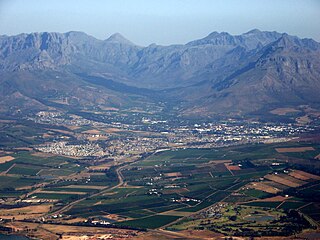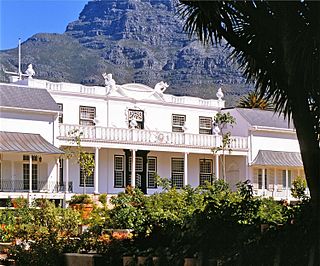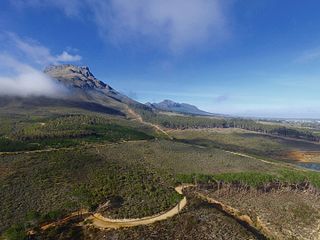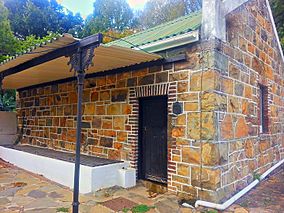
Stellenbosch is a town in the Western Cape province of South Africa, situated about 50 kilometres east of Cape Town, along the banks of the Eerste River at the foot of the Stellenbosch Mountain. The town became known as the City of Oaks or Eikestad in Afrikaans and Dutch due to the large number of oak trees that were planted by its founder, Simon van der Stel, to grace the streets and homesteads.
The following lists events that happened during the 1680s in South Africa.

Simon van der Stel was the first Governor of the Dutch Cape Colony (1691), the settlement at the Cape of Good Hope. He was interested in botany, establishing vineyards Groot and Klein Constantia, and producing a famous dessert wine. He is considered one of the founders of South African viticulture.

Somerset West is a town in the Western Cape, South Africa. Organisationally and administratively it is included in the City of Cape Town metropolitan municipality as a suburb of the Helderberg region . The vehicle registration code for Somerset West is CFM and the post code is 7130 for street addresses, and 7129 for post office boxes.

De Tuynhuys is the office of the president of South Africa, located in Cape Town.

Groot Constantia is the oldest wine estate in South Africa and provincial heritage site in the suburb of Constantia in Cape Town, South Africa.

The Danie Craven Stadium is a rugby union stadium in Stellenbosch, South Africa. Built in 1979, it is part of the Stellenbosch University's sport facilities. The stadium was named after rugby administrator and Springbok scrum half Danie Craven. The stadium holds 16,000 people.
Adam Tas was a community leader in the Cape Colony at the turn of the 17th century, and is best known for his role in the conflict between Cape Governor Willem Adriaan van der Stel and the Free Burghers at the Cape of Good Hope.

Willem Adriaan van der Stel was an Extraordinary Councillor of the Dutch East Indies, and Governor of the Cape Colony, a way station for the Dutch East India Company (VOC), from 23 January 1699 to 1707. He was dismissed after a revolt and was exiled to the Netherlands.
CapeNature is a governmental organisation responsible for maintaining wilderness areas and public nature reserves in Western Cape Province, South Africa.

Jonkershoek Nature Reserve is a CapeNature nature reserve located approximately 10 km (6 mi) south-east of the town of Stellenbosch in the Western Cape province of South Africa. It covers an area of approximately 11,000 hectares.

Coetzenburg Stadium is a multi-sports venue in Stellenbosch, South Africa, on a portion of the old Coetsenburg Estate which was founded by Dirk Coetsee in 1682 after a grant of land from the Dutch Governor of the Cape Colony Simon van der Stel. The stadium is owned by the Stellenbosch University.
Steenberg Estate is the site of the oldest farm in Cape Town, located in the suburb of Constantia. Steenberg is translates as “Mountain of Stone” and is named for the nearby mountain range. The manor house and other buildings on the farm have been declared a national monument. The estate has been redeveloped as a hotel, vineyard and golf course.

Stellenbosch Mountain is a mountain forming a prominent landmark overlooking the town of Stellenbosch in the Western Cape Province of South Africa. The mountain forms part of the Coetsenburg Estate, the Jonkershoek Nature Reserve, the Assegaaibosch Nature Reserve and the larger Hottentots-Holland Mountains Catchment Area.

Coetsenburg is an historic wine estate and one of the oldest estates in South Africa, established in 1682. It is located at the foot of the Stellenbosch Mountain, which forms part of the estate, in the town of Stellenbosch, 31 miles (50 km) east of Cape Town, in the Cape Winelands of the Western Cape Province. The estate has historically been owned by the Coetsee family and is currently not open to the public. The north-western portion of the original estate is now the Coetsenburg Sports Grounds which belongs to the University of Stellenbosch.
Dirk Coetzee/Coetsee was a Dutch colonist and the Hoofdheemraad (Chancellor) of the District of Stellenbosch and Drakenstein in South Africa for most of the 1690s and early 1700s. He also served as captain of the Stellenbosch Infantry and deacon of the Stellenbosch Moederkerk at different points in time. As captain of the Stellenbosch Infantry, which comprised mostly Huguenots, he provided military backing for a rebellion which began in 1706 against the Governor of the Cape Colony, Willem Adriaan van der Stel, whom the vrijburghers had accused of tyranny, corruption and racketeering. Coetsee was imprisoned in the dungeon of the Castle of Good Hope along with the other leaders of the Huguenots but he was released after a year. The rebellion ultimately succeeded in 1707 when the Dutch East India Company recalled the Governor and other colonial officials. An account of the rebellion is vividly described in the "Diary of Adam Tas".

Stellenberg is a suburb in Bellville, Western Cape South Africa.

Olof Bergh was an early Swedish-South African explorer and Cape Colony official as well as the progenitor of the well-known Bergh family in South Africa. He is also a former owner of South Africa's first wine estate "Groot Constantia" after Simon van der Stel. His accounts of his travels to the interior of the Cape Colony are among some of the first Dutch writings to originate on South African soil.

Anna de Coningh was the wife of early Swedish explorer Olof Bergh and the daughter of an enslaved woman, Angela van Bengale and François de Coninck of Ghent from the ship Drommedaris.
















